
Times are tough for India’s monument to love. Air pollution is turning its marble surface yellow. Restoration work is obscuring its famous minarets. Tens of millions of tourists still flock to Agra each year, but numbers are reportedly waning.
Critics of the Taj Mahal are also growing increasingly bold. In past months, religious nationalists in the Hindu-majority country have stepped up a campaign to push the four-century-old Mughal monument to the margins of Indian history. One legislator recently kicked up a national storm when he labelled the tomb “a blot”.
Resentment at the fact the country’s most recognisable monument was built by a Muslim emperor has always existed on the fringes of the Hindu right. But those fringes have never been so powerful.
Attacks on the monument, a lifeline for its home state of Uttar Pradesh, have grown so loud that last week the state chief minister – himself a critic of the Taj – was forced into “a day-long exercise in damage control”, one newspaper said.
Yogi Adityanath paid an elaborate official visit to Agra on Thursday to issue assurances that the Taj was a “unique gem” that his government was committed to protect.
“We should not delve deeper into the details of why, when and how the Taj Mahal was built,” Adityanath said. “What is important is that it was built by the blood and sweat of India’s farmers and labourers.”
At the heart of the controversy is a larger fight over India’s past and present. Hindu nationalists, among their ranks the prime minister, Narendra Modi, now wield unprecedented power across the country.
Many, including Modi, believe the hundreds of years in which north India was ruled by kings who practised Islam was a period of “slavery” no different from the British Raj.
“So they have a certain attitude towards any buildings that were built by Muslim rulers,” says Vishal Sharma, the secretary of the Agra Tourist Welfare Chamber.
Before he was appointed chief minister of Uttar Pradesh in February, Adityanath was best known for his fiery anti-Muslim rhetoric. He spent 11 days in jail in 2007 for inciting religious tension, once compared the film star Shah Rukh Khan to a terrorist, and has called for India to replicate Donald Trump’s Muslim travel ban.
Adityanath helped kick off the latest furore in June, when he said he was glad visiting dignitaries were no longer gifted a scale model of the monument, because it did not “reflect Indian culture”.
A tourism brochure recently published by his government omitted any mention of the Taj, but listed Hindu pilgrimage locations including the temple in eastern Uttar Pradesh where Adityanath serves as head priest.
Sangeet Som, a member of the ruling Bharatiya Janata party prone to inflammatory outbursts, went even further this month, labelling the 17th-century monument a “blot” on Indian culture that had been “built by traitors”.
“Taj Mahal should have no place in Indian history,” he said, claiming Shah Jahan, the emperor who built the mausoleum for his deceased wife, had “wanted to wipe out Hindus”.
“If these people are part of our history, then it is very sad and we will change this history,” he added.
Fuelling the controversy are the writings of a fringe historian, PN Oak, whose works were dismissed for decades but are enjoying new prominence among Hindu hardliners.
Oak claimed that much of the world was once ruled by an ancient Hindu empire, that the English language is a dialect of Sanskrit, and that Westminster Abbey is, in reality, a temple to the deity Shiva.
The Taj too, he argued, was originally a Shiva temple built by the maharajah of Jaipur, and initially named the “Tejo Mahalaya”.
His theory has been cited by several BJP legislators this month to cast doubt on the provenance of the monument. A dozen students were arrested at the Taj last week for offering prayers to Shiva on its grounds.
Historians are frustrated by the debate. “It is absolutely wrong and absurd,” says R Nath, a leading historian on the architecture of the Mughal era.
The history of the Taj is among the best chronicled of any Indian monument, recorded in detail at the time by three court historians.
“We know exactly how the land was acquired, how the foundations were laid and how it was built,” he says. “There is not a single piece of evidence to support this theory that it was a Shiva temple.”
Another historian, Rana Safvi, has obtained a rare copy of the actual property deed Shah Jahan used to obtain the land for the monument. “The evidence is clear that it was the site of an eminent and pleasant haveli [mansion],” she says.
She sees the Taj as the victim of a political campaign to reframe Indian history as a fight between Hindus and Muslims. “There is a lot of difference between colonists such as the British and rulers like the Mughals, who lived in India, married in India, and died in India,” she says.
“Except for brief periods under [the Mughal emperor] Aurangzeb, we don’t see great periods of communal strife,” she says. “They were the exceptions, not the norm.”
It was hoped that Adityanath’s about-face on the monument and his official visit last Thursday would mark the end of this latest storm. But the day after, the history wing of the Rashtriya Swayamsevak Sangh, a leading Hindu nationalist umbrella group, publicly called for Muslims to be banned from praying at the Taj site.
Sharma, the Agra tourism chamber secretary, is watching the continuing controversy with concern. “Whenever there’s unrest, even just reports of unrest, it affects tourism. The Taj brings in lots of foreign currency and even the domestic tourism is quite a lot,” he says.
“If they had to pick a side,” he adds, “Agra people would choose the Taj Mahal over this government.”
Source:_theguardian





